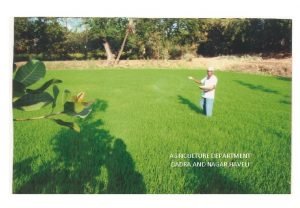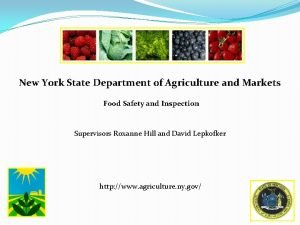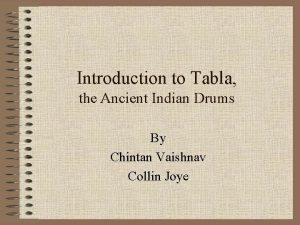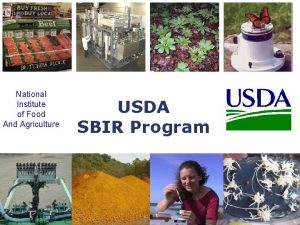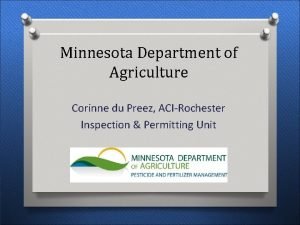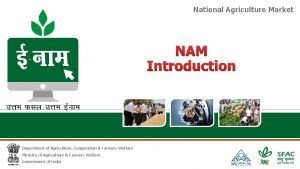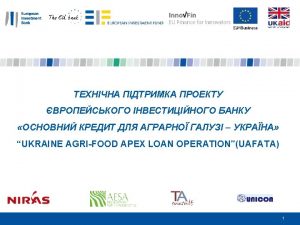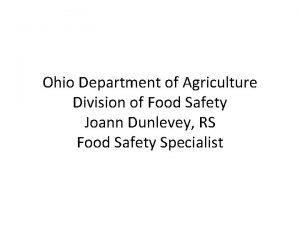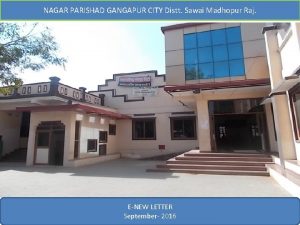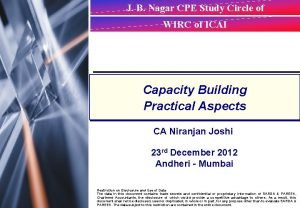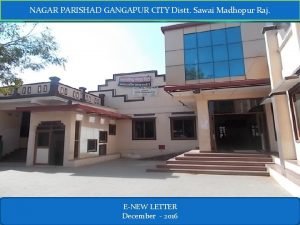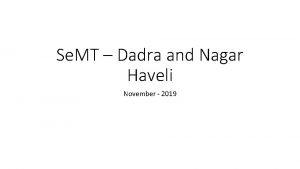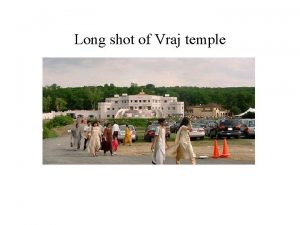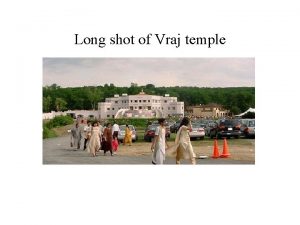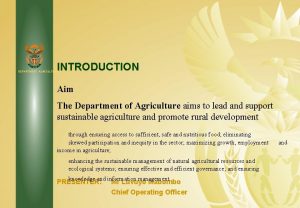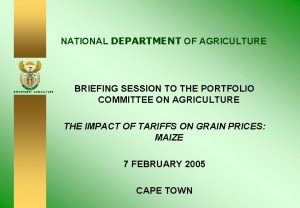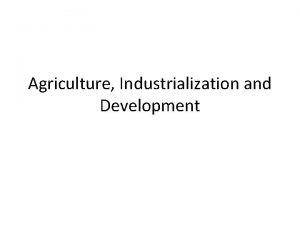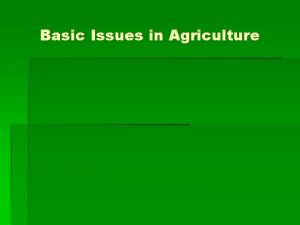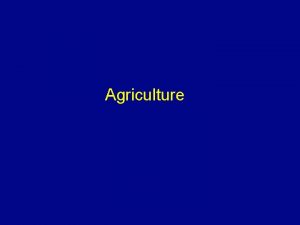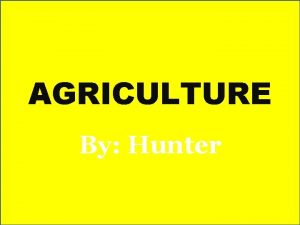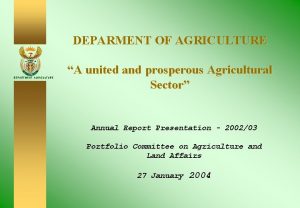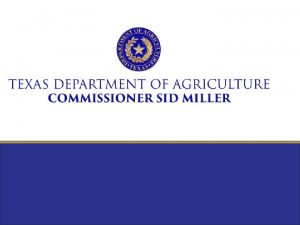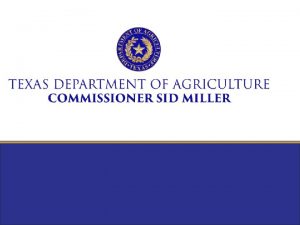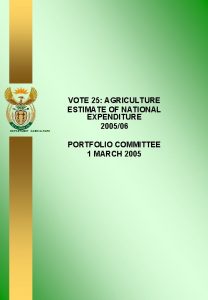AGRICULTURE DEPARTMENT DADRA AND NAGAR HAVELI STRATEGIES FOR





















- Slides: 21

AGRICULTURE DEPARTMENT DADRA AND NAGAR HAVELI

STRATEGIES FOR RESOURCE MANAGEMENT FOR BETTER INPUT USE EFFICIENCY NATIONAL CONFERENCE FOR RABI-2013 -14 DADRA AND NAGAR HAVELI (U. T)

OVER VIEW OF AGRICULTURE IN DADRA & NAGAR HAVELI. a). Geographical area 491 Sq. Km. b). No. of villages 72 c). Total cultivable land 19806 Hect. d). Command Area under canal Irrigation 4235 e). Command Area under LIS 1727 f). No. of farm Holdings 14000 g). Average size of holding 1. 41 Hect. h). Percentage of SC/ST farmer 91 % i). Percentage of ST population 62 % j). No. of small & marginal farmers 11245 k). Percentage of small & marginal farmers 80. 32 % l). Main staple crop grown Paddy m). Productivity of Paddy is 3100 kg/Hect. n). Average annual rainfall 2400 mm

(1) SOIL AND LAND: PRESENT LAND USE a. Geographical Area 49155 Hect. b. Total cultivable Land 19806 Hect. c. Average Size of Land Holding 1. 41 Hect. d. Area under Forest 20100 Hect. The department has carried out the soil testing in about 548 fields of farmers with the help of GSFC Ltd during Rabi-2012 -13 season for the various crops. It is found that the soils of Dadra & Nagar Haveli are rich in Potash , medium in phosphorus and medium to high in Nitrogen. Soil PH is 6. 5 -7. 5. For improving the potential and sustainable use of land resources, the farmers has been advised to go for judicious use of irrigation water, chemical fertilizers, weedicides and adopt organic farming and IPM to maintain soil fertility.

LAND HOLDING PATTERN : Paddy is the main staple crop. Besides, hill millets like Nagli, Ragi, Jowar, Maize, Niger, Black gram, Tur etc. are also grown under rainfed condition during Kharif. There is a tremendous potential for growing Horticulture crops like Mango, Cashew, Custard apple, Guava, Sapota etc. due to chronological agro-climatic and soil condition. There is no regulated market in the Union Territory. Crops grown under Kharif - Paddy, Ragi, Red gram, Urad (Black gram), Niger as a oil seeds in some pockets and Vegetables in rainfed condition. Crops grown under Rabi - Wheat, Gram, Mustard, Vegetables like Brinjal Tomato, Chillies, Bottle gourd, Bitter gourd, Lady’s finger etc. Perennial crops - Sugarcane & Banana. Plantation crops - Mango & Sapota (Chiku). 5

(2) WATER: There is one major irrigation project on Damanganga River. It is a joint venture between Daman & Diu, Dadra & Nagar Haveli & Gujarat. The project is already commissioned and gross command area of this U. T following under this project is 4077 Hect. Potential Irrigation utilization is about 10 to 12%. Besides, there are 151 Nos. of Govt Lift Irrigation schemes, taping water from wells, tube wells and on chech dams and other rivulets. Source wise area irrigated is as under ( 2011 -12). (Area in Hect) Sr. No 1. Govt. Private Canal Tube well Wells River Tube Well Other 1991 154 220 883 519 1029 2479 Grand Total 7275

IRRIGATION FACILITIES: The Damanganga Irrigation Project is the main source of irrigation for Agriculture but its benefit is limited to Silvassa, Dadra & Naroli and up to some extent in Dapada and Kilvani Patelads. There is no perennial source of irrigation in Randha, Dudhani, Mandoni, Amboli & Khanvel Patelads and agriculture entirely depends on rain. The basic problems in these Patelads are soil & water conservation to provide them gainful employment at their doorstep during lean period of agriculture season.

(3). ENERGY AND FARM POWER : The component of Farm mechanization is being implemented under the centrally sponsored programme of Macro Management of Agriculture scheme wherein the department is supplying Power Tillers and Winnowing fan to the eligible farmers. The bank loan is granted by the banks to purchase power tiller and amount of subsidy is directly credited in the loan account of the beneficiary. The department also provide custom hire services to farmers under which they are provided the facility of threshing machines for Paddy and Wheat crop on nominal charges. Small and marginal farmers constitutes 80. 32 % of the total cultivable land 91% farmers are SC/ST. Hence, 100% benefits of the scheme pass on to the small, marginal and women farmers only which belongs to SC/ST. • Subsidy for purchase of power-tillers: 40% subsidy is given on the cost of power tillers maximum to ` 45, 000/-. During the year 2012 -13, total 18 Nos. of power tillers has been distributed under the scheme. • Subsidy for purchase of winnowing fans : 25% of the cost maximum to ` 2000/- is given as assistance for purchase of winnowing fans

Bottlenecks : Majority of the farmers of this territory is SC/ST small & marginal farmers. As a result they have to depend on bank loans. Majority of the private banks are not cooperative and has negative approach for grant of agriculture loan to the farmers. This result delay in getting sanction from the banks and department is unable to incur the expenditure on subsidy amount in time. As a result, the release of the second installment is delayed.

TARGET AND ACHIEVEMENT UNDER THE MACRO MANAGEMENT OF AGRICULTURE FROM 2007 TO 2012 -13 Sr. No. (A) Year & component Target Achievement 2007 -08 1. Subsidy on supply of power tiller 07 Nos. 2. Subsidy on supply of winnowing fan 305 Nos. Total…. 312 Nos. 2008 -09 202 Nos. 209 Nos. (B) 1. Subsidy on supply of power tiller 05 Nos. 03 Nos. 2. Subsidy on supply of winnowing fan 134 Nos. Total…. 138 Nos. 2009 -10 Nil. 03 Nos. Subsidy on supply of power tiller Subsidy on supply of winnowing fan Total…. 2010 -11 Subsidy on supply of power tiller Subsidy on supply of winnowing fan Total…. 07 Nos. 170 Nos. 177 Nos. 07 Nos. 108 Nos. 115 Nos. 10 Nos. 75 Nos. 85 Nos. 10 Nos. 96 Nos. 106 Nos. (C) 1. 2. (D) 1. 2.

Sr. No. (E) Year & component Target Achievement 14 Nos. 15 Nos. 2011 -12 1. Subsidy on supply of power tiller 2. Subsidy on supply of winnowing fan Total…. 2012 -13 85 Nos. 99 Nos. 86 Nos. 101 Nos. Subsidy on supply of power tiller 07 Nos. 18 Nos. (F) 1. Total….

(4). AGRICULTURE INFRASTRUCTURE : The department is not having processing facility. There is no marketing surplus in the U. T except fruits like Mango and Chickoo which is getting remunerative prices in the nearby market. There is ready made market for perishable commodities as demand is greater than supply. Weekly haats also takes place in the entire part of the territory. Agriculture Input Supply: At field level, there are 11 distribution centres for different agriculture inputs located at various patelads of the territory. Each distribution centres has storage facility for storing agriculture inputs like seeds, fertilizers, pesticides, etc. All these inputs are distributed to farmers on loan and subsidy basis at village level itself.

(5). AGRO ADVISORY NETWORK : The UT is predominantly inhabited by tribal farmers & adopting primitive methods of Agriculture. There is no training & research support for Agriculture development exists in the U. T. The department of Agriculture completely depends upon the nearby Navsari Agricultural University of Gujarat State for the technical know-how. The Department is having Seeds cum demonstration farms where we demonstrate latest agricultural techniques to farmers. Also the truthful seeds of Paddy crop is supplied from Govt. farm. The Mango grafts are also provided on loan and subsidy basis. Farmers Training Centre: More than 600 Farmers are trained every year during three days training programme organized at FTC. One day of the training consists, visit to Agriculture University and Research Centre in the nearby are of Gujarat state for better exposure to farmers. The demonstrations plots are also laid at 70 nos. of places in the field of tribal farmers. The training on organic farming is also provided at FTC. The Khedut Shibir/one day camp is organized at the different part of the territory at six places as a pre-Kharif & pre-Rabi campaign. The specialists from the Agriculture University, Krishi Vigyan Kendra & Department of Agriculture provide guidance to the farmers on cultivation of seasonal crops & control of pest and diseases.

(6). CREDIT AND INSURANCE : U. T. Administration has taken up the issue of Kisan Credit Cards (KCC) on top priority basis and has carried out extensive campaigning to make the farmers aware of the benefit of KCC. Accordingly, camps have been organized at the Gram Panchayat level in different areas. Lead Bank Manager & other Bank officers, officers of Agriculture department & District Panchayat officers remain present full day. The farmers have been given the facility of copies of revenue records, Bank application form, photocopies of requisite documents at the camps site only. Loans for purchase of power tillers, diesel engines/electric motor is provided by the banks as required. There is poor participation from the private banks.

(7. ) HUMAN RESOURCE : There is shortage of field level functionaries like Extension Officers and Agriculture Assistants. There are only four Agriculture Assistants to look after the field work of entire U. T who are over loaded by work. Further, there is no separate department of Horticulture in the U. T. Deputy Director of Agriculture is looking after Horticulture with limited staff. Further, there is no extension & research support and inadequate expertise & the trained staff in field. As a result many farmers are not aware of the improved technology such as growth, regulators, harvest system, grading etc. KVK will soon be establish in the territory which is under process which will provide sufficient human resource directly helping the farming community.

ONGOING PLAN SCHEMES: SR. NO. . NAME OF SCHEME PATTERN OF ASSISTANCE 1. Distribution of fertilizer Subsidy of 40% on the cost of fertilizer is given to the SC/ST and marginal farmers in kind. The scheme is executed by District Panchayat. 2. Distribution of improved seeds 50% of the cost is given in kind to SC/ST and small and marginal farmers. The scheme is executed by District Panchayat. 3. Distribution of Horticulture plants Fruit grafts are provided to the farmers on 50% loan and 50% subsidy limited to ` 500/-. 4. Distribution of pesticides and Plant protection equipment. Assistance of ` 750/- for purchase of plant protection equipment in the form of spray pumps and assistance of ` 200/- for purchase of pesticides is given to the farmers on 50% loan and 50% subsidy basis. 5. Distribution of Agriculture Implements 50% of the cost is given in kind to SC/ST and small and marginal farmers limited to ` 500/-. 6. Farmers Training More than 600 Farmers are trained every year. Training on organic farming, IPM is also provided at FTC. 7. Financial incentive for commercial crop. 100% 8. Subsidy for purchase of diesel engine pump-set and Subsidy for purchase of Diesel engine pumpset and PVC pipes is PVC pipes given to the farmers. Loan is provided through banks and 50% subsidy is given by the department limited to NABARD cost.

Inputs distribution under various schemes during 2007 -08 to 2012 -13 Sr No 1. Name of Scheme 2007 -08 2008 -09 2009 -10 2010 -11 2011 -12 2012 -13 61 MT 66 MT 47. 63 MT 56 MT 55 MT 44. 28 MT 2. Distribution improved of Seeds @ 50% loan 50% subsidy Fertilizer 1302 MT 1246 MT 1520 MT 1440 MT 1368 MT 1351. 80 MT 3. Grafts 7008 Nos 6285 Nos 6732 Nos 7783 Nos 8601 Nos 8620 Nos 4. Storage bins 700 Nos 499 Nos 1000 Nos 1100 Nos 1250 Nos 1222 Nos. 5. Sprayers 258 Nos 482 Nos 40 Nos 200 Nos 239 Nos 6. Agriculture implements 194 Nos 200 Nos 205 Sets 1200 Nos 415 Sets 407 Sets 7. Pesticides 8. Oil Engine/Electric Motor Incentive on commercial crops Farmers trained at FTC 184 Ltr & 890 Kg 09 Nos 206 Lit. & 1130 kgs --- 371 lit 2047 ltrs. 19 Nos 1700 Kg/Lit --- 1905 Kg/Lit 19 2831 Kg/Ltr 9 ` 10000 ` 10760 ` 4420 ` 18936 ` 14, 600 ` 22522 603 Nos. 667 Nos. 628 Nos 643 Nos 625 Nos 631 Nos 72 Nos 73 Nos 70 Nos. 100 Nos 110 Nos 143 Nos 1166 1286 1277 1311 2128 1736 9. 10. 11. 12. Demonstration plot on Paddy crop Participation of farmers in one day camp / Khedut shibir

WORKSHOP FOR FARMERS VISIT OF HON’BLE COLLECTOR TO VILLAGE GUNSA

AGRICULTURE AT DADRA AND NAGAR HAVELI

WOMEN IN AGRICULTURE

THANK YOU
 Agriculture projects in dadra & nagar haveli
Agriculture projects in dadra & nagar haveli Florida dept of agriculture and consumer services
Florida dept of agriculture and consumer services Virginia department of agriculture food safety
Virginia department of agriculture food safety Maine dept of agriculture
Maine dept of agriculture Nys department of agriculture and markets license
Nys department of agriculture and markets license Keherwa taal notes
Keherwa taal notes Sc department of agriculture
Sc department of agriculture Usda sbir
Usda sbir Department of agriculture sbir
Department of agriculture sbir Doae.
Doae. Minnesota department of agriculture
Minnesota department of agriculture Site:slidetodoc.com
Site:slidetodoc.com Department of agriculture
Department of agriculture Ohio department of agriculture food safety
Ohio department of agriculture food safety Nagar parishad sawai madhopur
Nagar parishad sawai madhopur Nagar parishad gangapur city
Nagar parishad gangapur city Jb nagar study circle
Jb nagar study circle Medical superintendent
Medical superintendent Nagar palika gangapur city
Nagar palika gangapur city Humpty jumpty raipur
Humpty jumpty raipur Venky nagar
Venky nagar Kangaroo wings lajpat nagar
Kangaroo wings lajpat nagar
